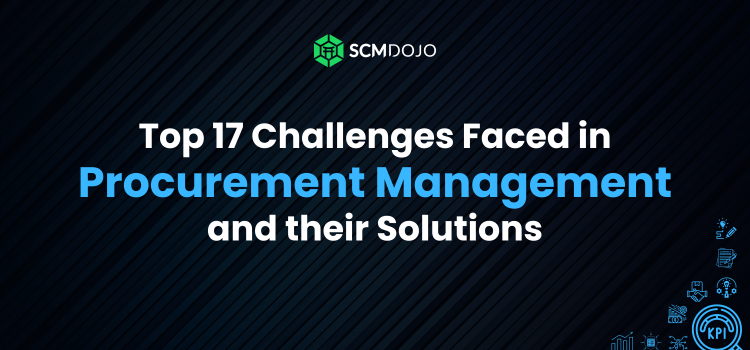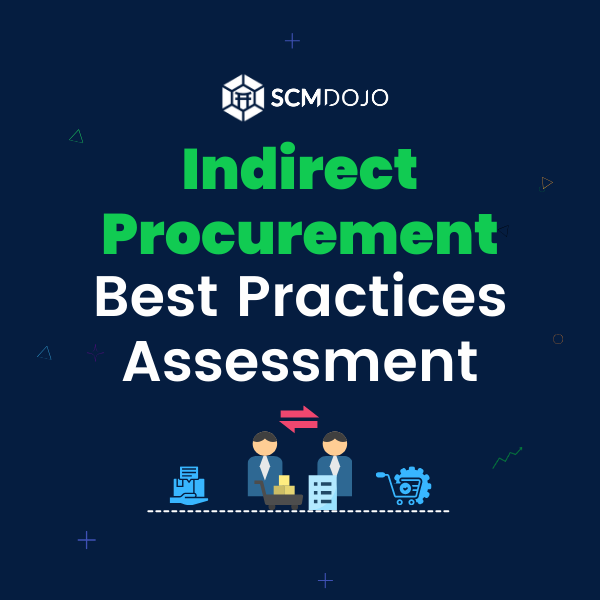Procurement is a complicated process, and it can be difficult to manage. Navigating regulations and setting prices pose numerous challenges in procurement that businesses must adeptly confront.
How many challenges in procurement and do you face in your day-to-day job yourself? Would you be able to list them?
For me, the biggest challenge I see for any procurement function is shifting procurement’s traditional focus on short-term cost savings’ to a more holistic objective that includes strategic supplier relationships, giving preference to longer-term cost efficiencies, and working with suppliers to identify opportunities to develop more innovative products and services.
Businesses today progressively see procurement systems as vital strategic contributors to their value plan and matching end-user goals. A dependable procurement system is one created to improve accuracy, efficiency, and speed. Due to this viewpoint observed by many, the necessity of standardizing business procedures within procurement and ensuring that all the best practices are followed becomes very important to the overall business plan.
But despite all safety measures taken in creating a standardized business strategy, problems in procurement are still known to occur. The challenges of procurement range from organizational inadequacies to human mistakes; these can again deliver adverse effects to a business’s procurement and purchasing capability.
Below is a list of the some of the most common challenges in procurement processes that we encounter across various organizations and solutions on how to tackle them as well in simple ways.
The 17 Common Challenges in Procurement and How to Overcome Them
1) Allowing Poor Quality for Lower Costs
In today’s business world, cost still plays a vital role in consumer products. We still see businesses hurtling down on cost even when the effects are detrimental to the product’s quality. In countless scenarios, the quality dimension gets altered to save cost, and the management holds high optimism hoping the quality risk does not get discovered.
SOLUTION: The use of consumer feedbacks has become helpful in striking a better balance, especially where an acceptable profit margin is reached.
To help you solve this issue, we have created a Procurement KPI Dashboard (Customizable Template), which you can use to track all your key quality and cost KPI. Identify declining trends, see which KPI are below targets, and drive remediation actions.
[button url=https://muddassirism.gumroad.com/l/procurement-kpi-Dashboard icon_size=32]Download Procurement KPI Dashboard[/button]
2) Providing Unclear Specifications & Requirements
Providing unclear specifications & requirements during procurement processes does not always turn out well and fits the ‘help me, help you’ scenario. Usually, suppliers could offer a much better job in delivering what the client requests if the organization make clear and defined requirements available during the procurement process.
SOLUTION: Clear details or specifications of what your organization requires would go a long way in solving this procurement challenge.
3) Not Doing Supplier Assessment Before Doing Business
Organizations habitually leave out Supplier Assessment and stick to what suppliers promise on paper. Keeping suppliers at arm’s length without any form of assessment before doing business leaves room for irregularities and untrustworthy experiences. A lack of trust on any side of the deal leads to various problems in procurement.
SOLUTION: Conduct thorough supplier evaluation criteria and/or assessment before you select any supplier. Once selected, actively include major suppliers during problem-solving processes. It leads to positive outcomes for overall growth. Treat your suppliers as strategic business partners.
4) Not Fully Understanding Supplier Capabilities
If you do not have a clear understanding of the supplier capabilities, then it is a sure way to get dissatisfied when possible procurement problems arise. Placing high expectations on a supplier to swiftly complete a procurement deal beyond his capability usually tends to be disastrous at the end. This procurement problem is amongst the biggest challenges facing procurement professionals when related to suppliers. The process, from identifying the best to ensuring stable and quality delivery, can be vital in seeking much more from your suppliers.
SOLUTION: Along with the usual procurement process, procurement professionals need to continuously monitor suppliers to ensure all delivery demands and standards are met. Start with gradual increment with timelines in place and quality agreed. In other words, hold a regular supply review, discuss key performance indicators and agree on action and improvement ideas.
5) Not Agreeing on Important KPI
Following the above point, executing the best practice of procurement. Best practices in supply chain functions using five essential dimensions (variation, variety, velocity, visibility, and volume). Many procurement experts do not appreciate the need for critical questioning that addresses what a new supplier brings into the balance. Factors like purchasing price variation, percentage cost reduction, quick delivery, etc. can be valuable but not enough. Additionally, these measures often result in conflict with significant strategic actions that offer a real and sustainable impact.
SOLUTION: Once KPI’s are agreed they should be the main agenda item for regular supply review. The management system should employ measures involving a procurement system that offers a balance between cost, customer value, quality, and speed.
6) Lack of Transparency
The withholding of crucial information by organizations tends to create challenges in procurement process that limits suppliers from offering jam-packed values to clients. Critical data like market trends, product changes, and sales forecasts generate unwanted surprises that may hamper your relationship with your suppliers.
SOLUTION: Ask for the supplier’s demand or details required to offer quality services. Keep a request line open about these demands as well as updates whenever there are new requirements.
7) Lack of Trust
In cases of zero trust for a supplier, such organizations usually hold suppliers at arm’s length. The treatment is also similar to one filled with zero confidence. The show of lack of trust towards suppliers may not go down well with some, and this could lead to a variety of procurement issues. But still, maintain safety first, do not trust blindly.
SOLUTION: Show some level of trust towards your key suppliers. The light show of confidence would aid your problem-solving methods and yield positive improvements.
8) Doing Business Without a Formal Contract
I am still get astonished to find out many companies have over 40% suppliers in their suppliers list without a formal contract. I would consider this as one of the most common procurement challenges that can prove to be quite problematic.
The creation and amending of legal contracts and paper works may be time-consuming and challenging. This procurement problem could arise when there is regular request (for Expressions of Interest, Proposal, Quotation, etc.) and managing them takes up time. Such procedures ought to be straight, fair, and thoroughly implemented. Even though it requires an excellent undertaking for procurement teams, avoiding them may further create more procurement problems.
SOLUTION: Create a straight, fair, and thoroughly implemented approach for formal contracts. No matter how challenging the process may be, business is business and should be done with official agreements. And it should be done regardless of how big or small the supplier is.
9) Not-so-Clear Business Procurement Function Processes
While normal basic purchasing processes are usually well defined, several procurement function processes that are equally essential are often not clearly defined. Just to name a few of such key processes; supplier development, Procurement function training & development, Procure-to-Pay (P2P). JIT Purchasing and strategic sourcing. Misplacing these processes could lead to reactive procurement problems.
SOLUTION: Make use of procurement systems and leadership principles that offers a clear and compelling business process.
10) Accidental Orders
Ordering the wrong items or quantities can lead to serious procurement problems with your suppliers. Nowadays, the speed of transactions leaves little or no room for ordering errors. Though not common, Accidental Orders would necessitate several checks and balances all throughout the system. If no protocol permits or supports reversals and safeguards against mistakes, then such problems are likely to take more time.
SOLUTION: If you maintain a good connection with your supplier, an immediate follow-up would be activated to rectify such mistakes. Good connections would save you from significant difficulties in the long run.
11) Continue Working with Inflexible Suppliers
Several procurement decisions are made alongside the business’s risk management strategy. Things like low costs better reflect on the result of company activity. Nevertheless, some suppliers may not make discounts available or maintain the inclusion of specific surcharges. As a skilled procurement professional, you need to often find room for negotiation with your suppliers.
SOLUTION: Before selecting a supplier, see what negotiating options like discounts would be beneficial to your business. Stick with suppliers who identify and accommodate your business desire to maximize performance.
12) Not Having a Dedicated Development Plan for Buyers/Procurement Managers
Whilst most companies ask for CIPS or ISM, very few actually go out and support their procurement team members to continuously develop functionally. I have seen a lot of buyers asking for monetary support and getting rejected due to “business reasons”. In my observation, this is one of the most common procurement challenge.
SOLUTION: We as business leaders know the importance of technical knowledge, so why don’t we support it to that extent? If there are limited funds then there are a lot of Procurement Courses, Procurement Blogs, and Procurement Books which can really benefit in the development of the procurement function and also help buyers to prepare for the next procurement interview.
13) Lack of Accurate Data
Creating purchase orders based on erroneous procurement data can cause excess inventory, inventory shortages, and other supplementary procurement challenges with the potential to directly affect your organization’s bottom line.
SOLUTION: Whenever you want to make procurement decisions, make sure you are only using and relying on accurate and reliable data.
14) Continuing to Focus on Cost Reduction
As mentioned earlier, cost reduction is the key focus for most procurement functions. An often-desired goal is having procurements accomplished on time and under budget. So, a decrease in cost for the latter may help realize some savings. But several problems may arise if more focus is placed on going under the budget.
The most classic example where procurement function gets caught is outsourcing to Best Cost Countries (or Low-Cost Countries) without considering the implications to total wall-to-wall cost, quality, delivery, lead time and in turn inventory.
SOLUTION: With every cost reduction project, the procurement team must consider implications to wall-to-wall cost, quality, delivery, lead time, freight cost, trade compliance issues and in turn inventory. It is not always necessary that if the piece price is low, it is a good thing!
15) Not Knowing Which Supplier to Develop or Replace
Identifying which supplier to develop or replace requires careful attention to retaining the right supplier for your business. Therefore, I have written an article on “Are You More Like a Reactive or Strategic Supplier Development Professional?”, where I have given a perspective of which supplier to develop strategically and which to develop reactively. Provision of the necessary support and services is always essential to continuous development.
SOLUTION: Investigate specific suppliers’ motivations to participate in supplier development programs and how buyers can influence suppliers who are not dependent upon them to participate in supplier training and technology/ product development.
16) Ignoring the Costs of Time
Lower prices from suppliers habitually come with long lead times. We hardly ever see organizations provide a comprehensive analysis of those protracted lead times and their cost implication, missed deadlines, waste, working capital, and overall consumer satisfaction.
SOLUTION: Time is always a significant factor for procurements, select a supplier whose price range meets your organization’s demand.
17) Tolerating Unnecessary Risk
All procurement systems ought to comprise of risk assessment covering supply commotion and the subsequent implications. There are too many circumstances where strategic procurement could encounter unnecessary risk that may lead to procurement problems.
SOLUTION: Be open about your possible risk options, and implement measures to tackle all unnecessary risk.
Get Stocktaking: The Ultimate Guide to Creating Your Very Own Customised Stocktake Procedure
And Voila! Procurement Problems and Solutions Simplified.
Several organizations are often faced with a variety of procurement problems and challenges. The implementation of best practice procurement systems would seek to integrate different measures and high-performance business processes to solve these problems.
I recently had an interview with Procurement Expert Richard Beaumont who argues why procurement professionals do not need to be on the Board, why buyers will be obsolete, how to manage your boss who is not a procurement expert and why sorting data is key! I think you will find it quite useful.
Hope you liked our extensive guide to the top solutions to procurement challenges. If you think I have missed any procurement issue worth mentioning, please let me know in the comments below!
Frequently Asked Questions (FAQs)
What are the common procurement challenges?
Common procurement challenges involve navigating regulations, setting competitive prices, ensuring supplier reliability, managing risks, and maintaining efficient communication throughout the procurement process.
What are the key procurement issues?
Key procurement issues include various challenges and considerations that organizations face when acquiring goods or services. These issues include ensuring supplier reliability and compliance with quality standards, managing costs to optimize budget utilization, mitigating risks related to supply chain disruptions or geopolitical factors, and promoting ethical and sustainable sourcing practices. Additionally, effective communication and collaboration between procurement teams and other departments are crucial for aligning procurement strategies with overall business objectives. Balancing the need for efficiency with the necessity for detailed vendor evaluation and negotiation is an ongoing challenge.
How can procurement challenges be overcome?
Overcoming procurement challenges involves strategic measures like implementing vendor management systems, fostering transparent communication, utilizing technology for automation, and conducting regular risk assessments. Diversifying suppliers and staying informed about market trends further contribute to building a resilient procurement strategy.
How do you control procurement?
Effective procurement control involves implementing stringent processes to monitor and manage the entire procurement lifecycle. This includes establishing clear policies and procedures, conducting regular audits to ensure compliance, and utilizing technology for tracking and reporting. Centralized decision-making, strategic vendor management, and continuous performance evaluation contribute to maintaining control over procurement activities. By encouraging a culture of transparency and accountability, organizations can reduce risks and improve their procurement processes.
References
About the Author- Dr Muddassir Ahmed
Dr MuddassirAhmed is the Founder & CEO of SCMDOJO. He is a global speaker, vlogger and supply chain industry expert with 17 years of experience in the Manufacturing Industry in the UK, Europe, the Middle East and South East Asia in various Supply Chain leadership roles. Dr. Muddassir has received a PhD in Management Science from Lancaster University Management School. Muddassir is a Six Sigma black belt and founded the leading supply chain platform SCMDOJO to enable supply chain professionals and teams to thrive by providing best-in-class knowledge content, tools and access to experts.
You can follow him on LinkedIn, Facebook, Twitter or Instagram






